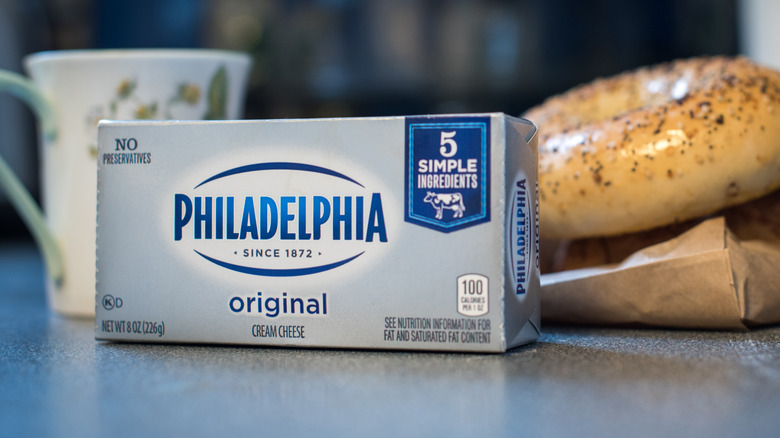The Reason Philadelphia Cream Cheese Is Packaged In Foil
Whether you're spreading it on a freshly made bagel or using it as a filling for some stuffed jalapenos, cream cheese provides you with that special something that other smears just can't replicate. Butter may come close, but it's lacking that sweet and milky cheese flavor full of satisfaction. For years, cream cheese has been that secret ingredient doubling as a condiment, providing just the right textures and flavors to tons of meals. In fact, its history is just as rich as its essence, filled with fascinating facts, and one of them centers on the very packaging it comes in.
Kraft's Philadelphia cream cheese notably comes packed in foil, and this is because it can be used as a thin barrier to keep out its number one enemy: Oxygen. However, this is merely one reason, making it quite profound how logistics and marketing also played into its usage. Since the late 1800s, Kraft's Philadelphia cream cheese has been wrapped up and sold the same way. The company's world-famous, high-quality product is the proof that's in the pudding, or, rather, cream cheese.
The foil wrapping used for Philadelphia cream cheese
When you're at the store and you see the cream cheese section, you'll most likely find Kraft's Philadelphia cream cheese in plastic tubs or brick-shaped packages. If you're one for nostalgia and high-quality cream cheese, you'll most likely go for the latter choice. Once you're home and you begin to unpack your cream cheese, you'll notice that thin layer of foil wrapping around the brick of cream cheese. Kraft uses this foil to keep out oxygen and light and reduce any oxidation. Moisture and any harmful bacteria are also kept out which then allows for cream cheese to be stored for longer periods, even when it's not refrigerated. This packaging allows your precious cream cheese to maintain its high quality for a longer period of time.
While Kraft hasn't officially disclosed why the foil-wrapped cream cheese comes in a brick-like shape, it's likely to do with logistics. Given the soft texture of cream cheese, it needs to be wrapped up to preserve its shape, and years ago, this brick shape was the most useful when packing large quantities of cream cheese into shipping boxes.
Marketing was another reason to keep the foil
In the late 1800s when dairyman William Lawrence partnered with A.L. Reynolds, a New York cheese distributor, they needed a name for their product. They also needed something to differentiate it from all the other cheese products available at the time. Despite being made in New York, the name Philadelphia cream cheese was used to not only make it more unique but to cater to people's taste for the best cheese. During this time, some of the best dairy and cheese were being farmed and sold in the Philadelphia area. Reynolds realized this and suggested to Lawrence that they use the name "Philadelphia cream cheese."
It stuck and was another reason foil was used. Once they finalized the name and logo, the goal was to prominently display it on every product. The selection of foil was deliberate, driven by its exceptional printability. Hence, it was the ideal convergence of logistics, marketing strategies, and food preservation techniques that paved the way for the globally acclaimed and beloved Philadelphia Cream Cheese we cherish today.


